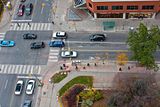ShonTron
Moderator
Someone with close contacts at City Hall confided to me that the majority of those involved in the planning and upkeep of Toronto's public realm drive and live in the suburbs. Their priorities lie elsewhere and even under Miller the city struggled to hire people who lived in the old city because any preference based on location would be deemed as discrimination.
At least this is not entirely true. I regularly encounter one of the managers for this area cycling along Dundas to work.





